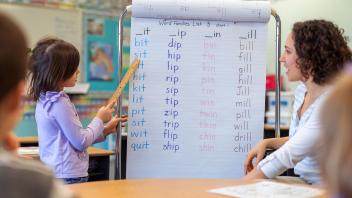In addition to phoneme awareness and letter knowledge, knowledge of sound-symbol associations is vital for success in first grade and beyond. Accurate and fluent word recognition depends on phonics knowledge. The ability to read words accounts for a substantial proportion of overall reading success even in older readers.
Good readers do not depend primarily on context to identify new words. When good readers encounter an unknown word, they decode the word, name it, and then attach meaning. The context of the passage helps a reader get the meaning of a word once a word has been deciphered.
The Report of the National Reading Panel states that explicit, systematic, synthetic phonics (in synthetic phonics, children are taught to blend individual speech sounds into words) is significantly more effective than other types of phonics such as incidental, embedded, or whole-to-part phonics.
The ability to spell is generally improved with systematic phonics instruction even in children who read relatively well. Instruction in word recognition, moreover, should include not only sound-letter correspondences, but also sight words, syllabication (breaking words into syllables), and morphology (breaking words into meaningful parts).
By the end of second grade, students should be able to decode almost any unfamiliar word so that they can attend to uncovering the meaning. The extent to which students will depend on explicit, systematic teaching will vary, but teachers need to be prepared to teach everyone, including those who do not learn to decode with ease.
Teachers cannot teach the relationships between speech and print systematically, explicitly, and skillfully unless they themselves understand how spelling represents sounds, syllables, and meaningful parts of words. English is a predictable, albeit complex language that children can approach with confidence if their teachers present the system itself as one with logic and structure.
Teachers need knowledge, guidance, and practice, however, if they are to teach in a way that improves on the ineffective drills and worksheets that may have been misused in the past.
Excerpted from: The Content of Professional Development. (November, 2000). Every Child Reading: A Professional Development Guide. Learning First Alliance. Reprinted with permission.
Copyright © 2000 by the Learning First Alliance. Learning First Alliance member organizations include: American Association of Colleges for Teacher Education, American Association of School Administrators, American Federation of Teachers, Association for Supervision and Curriculum Development, Council of Chief State School Officers, Education Commission of the States, National Association of Elementary School Principals, National Association of Secondary School Principals, National Association of State Boards of Education, National Education Association, National Parent Teacher Association, National School Boards Association. For more information, see www.learningfirst.org
